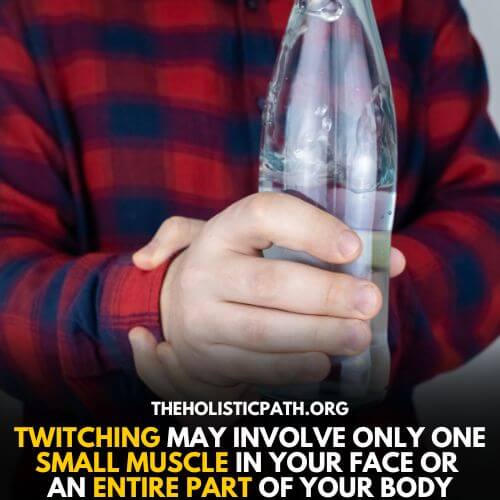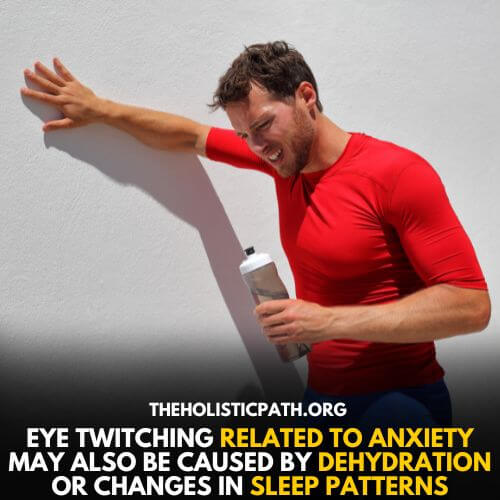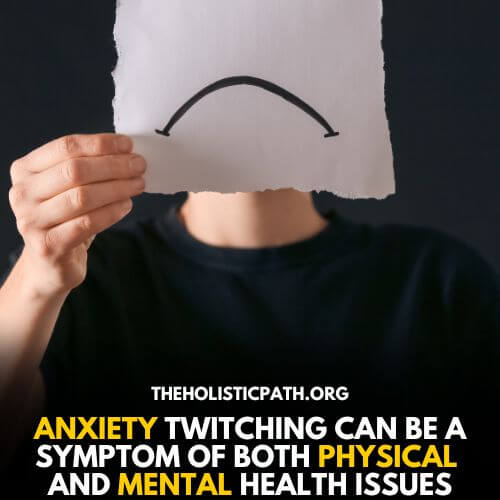Anxiety is a common mental health condition that affects millions of people around the world. It can manifest in many different ways, and sometimes it’s hard to tell if something is an anxiety symptom or something else entirely. Twitching, also known as muscle fasciculation, can be an indicator of anxiety but it can also signal other issues such as injury or illness.
In this article, we’ll take a look at what twitching is, what causes it, and discuss whether or not ‘is twitching a sign of anxiety’. We’ll explore some treatments for both anxiety and twitching and provide tips on how to cope with these conditions. By the end of this article, you should have a clearer idea about whether or not twitching could be caused by anxiety.
What Is Twitching?
Twitching is a sudden, involuntary contraction of a muscle or group of muscles. It can be caused by simple things like fatigue or strain but it can also indicate something more serious. Twitching may involve only one small muscle in your face or an entire part of your body such as the arms and legs.

There are two types of twitches: focal and generalized. Focal twitches usually occur in just one area, while generalized twitches affect multiple areas at once. In some cases, the twitching can be quite mild and barely noticeable; however, it can also be severe enough to cause significant discomfort.
Signs And Symptoms Of Twitching
The signs and symptoms of twitching vary depending on the severity of the condition. Generally, people experience a variety of sensations that can range from mild to severe. Some common signs and symptoms include:
Signs of twitching
- Muscle spasms or jerking movements.
- Pain or discomfort in the affected area.
- A twitching sensation that is sometimes accompanied by a tingling feeling.
- Difficulty concentrating on tasks due to the distraction caused by the twitching.
- Excessive fatigue in the affected area.
- Loss of coordination or balance.
- Weakness in the affected area
- Muscle twitches that are visible to the naked eye.
- Difficulty sleeping due to the twitching sensation
- Irritability is caused by discomfort and pain associated with the twitching.
Symptoms of twitching
- Muscle cramps or contractions.
- Difficulty breathing due to spasms in the chest area.
- A feeling of tightness or tension in the affected area.
- Numbness or tingling in the affected area
- Twitching is triggered by emotional stress or physical exertion.
- Unexplained twitching occurs without any apparent cause.
- Pain or discomfort in the affected area.
- Abnormal posture due to muscle spasms and contractions.
- Difficulty speaking due to spasms of the facial muscles.
What Causes Twitching: 10 Possible Reasons
Twitches can be caused by a variety of different factors. Common causes include:
- Muscle Strain or Injury: Overuse of muscles, such as from vigorous exercise, can cause them to become strained and lead to twitching. Injuries can also cause twitching as the body attempts to repair the damage.
- Stress and Anxiety: Stress and anxiety are common causes of twitching, as these can cause muscles to tense up involuntarily. This type of twitching is usually focused on one or two areas, such as the face or legs, but can also affect multiple areas at once.
- Injury or Illness: Injury or illness can also cause twitching, as damaged muscles may twitch in response to certain stimuli. This could include something as simple as brushing your skin lightly or applying pressure to an injured area.
- Medication Side Effects: Certain medications can have side effects that include muscle twitches. These could be prescription drugs such as antidepressants or painkillers, or over-the-counter medication like ibuprofen.
- Nutritional Deficiencies: Certain nutritional deficiencies can also lead to twitching. These include a lack of vitamins B and D, as well as magnesium and calcium.
- Physical Causes: Muscle strain or fatigue is the most common physical cause of twitching. If you’ve been over-exercising or working out too much, your muscles may become strained and start to twitch involuntarily. Other physical causes include electrolyte imbalances and dehydration, which can lead to involuntary muscle contractions.
- Psychological Causes: Stress and anxiety are two of the most common psychological causes of twitching. When we become stressed or anxious, our body releases hormones that can affect our muscles. This can lead to twitching in certain parts of the body such as the eyelids or lips.
- Neurological Causes: Neurological issues such as cerebral palsy, multiple sclerosis, and Bell’s palsy can all cause twitching. In some cases, the twitches may be caused by neurological disorders or diseases.
- Sleep Deprivation: Not getting enough sleep can cause our muscles to become fatigued and lead to twitching. This is because when we don’t get enough rest, our body will start to break down the muscle tissue in order to make energy for us.
- Dehydration: Dehydration can also cause twitches, as lack of fluids leads to electrolyte imbalances in the body. This can lead to involuntary contractions of the muscles.
Is Twitching A Sign Of Anxiety
Twitching can be a sign of anxiety, as both physical and psychological stress may cause involuntary muscle contractions. Anxiety can cause muscles in the face, arms, legs, and other parts of the body to twitch or jerk involuntarily. The twitches can range from mild to severe and usually last for a few seconds to minutes.
In some cases, they may even persist for several hours or days before subsiding.
Research has suggested that people with anxiety are more likely to experience twitching than those without anxiety. A study by researchers at the University of Wisconsin found that people with higher levels of reported stress were significantly more likely to experience facial twitching than those with lower levels of reported stress.
Additionally, research has shown that people who experience anxiety are more prone to muscle twitches caused by a variety of factors, including physical stress, lack of sleep, and poor nutrition. Although twitching can be a sign of anxiety, it is important to note that not all twitches are caused by anxiety.
Is Eye Twitching A Sign Of Anxiety
Eye twitching, or myokymia, is a common symptom of anxiety. It typically manifests as an involuntary eyelid spasm that may last for a few seconds to a few minutes. In most cases, it affects the lower eyelid and can be seen even with the eye closed. It occurs in both eyes but usually affects one side at a time.
The exact cause of eye twitching is not well understood, but it is thought to be related to stress or fatigue.
Anxiety can produce high levels of stress hormones such as cortisol and adrenaline, which can lead to muscle tension throughout the body and cause certain muscles – including those around the eye – to involuntarily contract. Eye twitching related to anxiety may also be caused by dehydration or changes in sleep patterns.

Though anxiety-related eye twitching is usually harmless, some people experience more frequent or intense episodes that persist for longer than normal. If this happens, it’s important to talk to your doctor about possible treatment options such as relaxation techniques, lifestyle modifications, or medication that can help reduce anxieties and relax facial muscles.
4 Common Types Of Eye Twitching
Eye twitching is an uncontrollable spasm of the eyelid. It can also cause light sensitivity, blurry vision, watery eyes, and dry eyes. Eye twitching is classified by the area of the eye that is affected. Common types of eye twitching include:
- Blepharospasm – This type of eye twitching affects both eyelids and causes them to close tightly, followed by rapid opening and closing movements. Blepharospasm is usually accompanied by light sensitivity and can be very uncomfortable for those who experience it.
- Myokymia – Myokymia involves brief, involuntary contractions of a single muscle in the eyelid that make it appear as though it is flickering or “twitching”. These spasms may last a few seconds or minutes before disappearing on their own. Myokymia is more common in people who are prone to anxiety or stress.
- Oscillopsia – Oscillopsia is a type of eye twitching that causes the entire eyeball to move back and forth uncontrollably. This can result in blurry vision, difficulty focusing on objects, and light sensitivity. It may also be accompanied by other symptoms such as watery eyes and dryness due to excessive blinking.
- Tremor – An eyelid tremor is an involuntary rhythmic movement of one or both eyelids that usually resolves on its own after a few seconds or minutes. This type of eye twitching tends to occur during times of heightened stress or when you are feeling tired or fatigued.
No matter what type of eye twitching you are experiencing, it is important to seek medical attention if the twitching persists or becomes more severe. Your doctor can help determine the underlying cause and provide treatment options that may help reduce the frequency and intensity of your symptoms.
What Do Anxiety Twitches Feel Like?
Anxiety twitches can manifest in a variety of ways, ranging from subtle tingling sensations to more noticeable muscle movements. They are usually caused by stress or tension and can happen anywhere on the body. This is what anxiety twitches feel like:
- Tightness: Anxiety twitches often feel like a tightness in the muscles around the eyes or face. This is because anxiety triggers the body’s fight or flight response, which causes increased muscle tension throughout the body. People who experience this type of twitching often report feeling as though their eyelids are pulling tightly together and they can’t relax them.
- Twitching Sensation: In addition to feeling tightness, some people also experience a twitching sensation in the affected area. This sensation may be mild or intense depending on the severity of the anxiety. These spasms can last for several seconds and may be accompanied by light sensitivity and blurred vision.
- Pressure: Anxiety twitches can feel like pressure or tension in the muscle. It may be localized to one specific area or radiate throughout the body depending on the person and their individual response to stress. The sensation can range from mild to severe with some people feeling as though their entire body is under strain.
- Tingling: The twitching associated with anxiety can also produce a tingling sensation in the affected area. This can vary from faint prickles to uncomfortable pins and needles, depending on how intense the anxiety is at that moment.
- Cramping: In addition, some people experience cramps when their muscles twitch due to anxiety. These cramps are usually more intense than the tingling or pressure sensations and may be a sign of deeper muscular tension or strain.
- Pain: In certain cases, anxiety twitches can be accompanied by sharp pains that can radiate throughout the body. If these symptoms are persistent or severe, it is important to talk to your doctor as soon as possible in order to rule out any underlying medical conditions.
4 Ways To Diagnose Anxiety Twitching
Anxiety twitching can be a symptom of both physical and mental health issues. In order to accurately diagnose the cause, it is important to speak with a qualified healthcare professional who can conduct an evaluation and recommend appropriate treatments. Here are some of the ways to diagnose anxiety twitching:
- Physical Examination: Your doctor may begin by conducting a physical examination in order to check for any underlying medical conditions that could be causing your symptoms. This may include taking your pulse, checking your reflexes, and examining your eyes and facial muscles.
- Blood Tests: In some cases, blood tests may also be used to help rule out other potential causes of eye twitching such as thyroid disorders or vitamin deficiencies. Your doctor may also order an electroencephalogram (EEG) to measure your brain’s electrical activity and look for any abnormalities.
- Psychological Evaluation: Your doctor may refer you to a mental health professional, such as a psychologist or psychiatrist, for a psychological evaluation. This will help them determine if anxiety is the cause of your twitching and recommend appropriate treatments. They may also ask you questions about your lifestyle, stress levels, and any other symptoms that you are experiencing.
- Imaging Tests: In rare cases, imaging tests such as CT scans or MRIs may be necessary to rule out any neurological problems that could be causing your symptoms. These tests can provide detailed images of your brain and can help identify any abnormalities.
5 Treatments For Anxiety Muscle And Eye Twitches
The treatment for anxiety twitches will depend on the underlying cause and severity of your symptoms. Here are some of the treatments that may be used to reduce muscle tension, eye spasms, and other symptoms associated with anxiety:
- Medication: Your doctor may recommend medications such as anti-anxiety drugs or antidepressants to help reduce your symptoms. These can help regulate mood, improve sleep quality, and decrease muscle tension.
- Cognitive Behavioral Therapy (CBT): This type of therapy focuses on changing negative thought patterns in order to reduce stress and anxiety. A qualified mental health professional can teach you how to manage your thoughts in a more positive way and develop healthy coping strategies when faced with difficult situations.
- Exercise: Regular exercise can help reduce stress levels and improve your overall mood. It is important to find an activity that you enjoy in order to maximize the benefits of physical activity.
- Relaxation Techniques: Practicing relaxation techniques such as deep breathing, progressive muscle relaxation, or visualization can help reduce muscle tension and eye twitching associated with anxiety. These techniques can also be used to manage stressful situations and reduce your overall anxiety levels.
- Dietary Changes: Making dietary changes may also be beneficial for reducing symptoms of anxiety twitching. Eating a balanced diet that includes plenty of fruits, vegetables, lean proteins, and whole grains can help promote mental well-being. Avoiding caffeine, alcohol, and other stimulants can also help reduce anxious feelings.
Overall, anxiety twitching can be a symptom of both physical and mental health issues. It is important to speak with a qualified healthcare professional in order to accurately diagnose the cause and receive appropriate treatment. With proper care, you can manage your symptoms and improve your quality of life.
12 Simple Ways To Prevent Anxiety Twitches
In order to prevent eye twitches and muscle spasms caused by anxiety, it is important to maintain good physical and mental health. Here are some tips that can help reduce the occurrence of these symptoms:
- Get plenty of rest: Getting enough sleep will help your body and mind stay rested and relaxed. Aim to get 7-8 hours of sleep each night.
- Exercise regularly: Regular physical activity is a great way to reduce stress levels and promote relaxation. Try to incorporate moderate exercise into your daily routine, such as walking or yoga.
- Practice relaxation techniques: Relaxation techniques such as deep breathing, progressive muscle relaxation, or visualization can help you manage stressful situations and reduce anxiety twitching.
- Avoid stimulants: Caffeine and other stimulants can increase anxiety levels and worsen symptoms of eye twitching. Try to limit your intake of these substances in order to reduce the risk of twitching.
- Eat a balanced diet: Eating a well-balanced diet that includes plenty of fruits, vegetables, and lean proteins can help promote mental well-being and reduce anxiety levels.
- Identify triggers: Keep track of situations or activities that tend to increase anxiety levels.
- Spend time in nature: Being outside can help reduce stress and improve your overall well-being.
- Practice mindfulness: Taking time each day to focus on the present moment can help reduce anxious feelings and eye twitching associated with anxiety.
- Take breaks from technology: Taking a break from TV, computers, and other electronic devices gives your mind a chance to rest.
- Avoid overexertion: Pushing yourself too hard can lead to increased muscle tension and stress levels.
- Connect with loved ones: Spending quality time with family and friends can boost mood and reduce anxious thoughts.
- Talk to your doctor: If you are experiencing frequent eye twitches or other symptoms associated with anxiety, it is best to speak with a qualified healthcare practitioner in order to receive an accurate diagnosis and appropriate treatment plan. Seeking professional support from a qualified mental health professional can help you manage your symptoms and improve your quality of life.
By following these simple tips, you can help prevent and manage any twitching associated with anxiety so that you can feel more relaxed and comfortable in your everyday life.
Takeaway
In conclusion, twitching and eye twitching can be a sign of anxiety. If the symptoms persist or worsen, it is important to speak with a qualified healthcare professional in order to receive an accurate diagnosis and appropriate treatment plan. Taking steps to reduce stress levels and maintain good physical and mental health can help prevent anxiety twitching from occurring. With proper care and support, you can manage your symptoms and improve your overall quality of life.
References
Blackman, G., Cherfi, Y., Morrin, H., Ellis, C. M., Bashford, J., Ruths, F., & David, A. S. (2019). The Association Between Benign Fasciculations and Health Anxiety: A Report of Two Cases and a Systematic Review of the Literature. Psychosomatics, 60(5), 499–507. https://doi.org/10.1016/j.psym.2019.04.001
Burgess, L. (2019, March 7). Causes of muscle twitches and how to relieve them. https://www.medicalnewstoday.com/articles/324641

